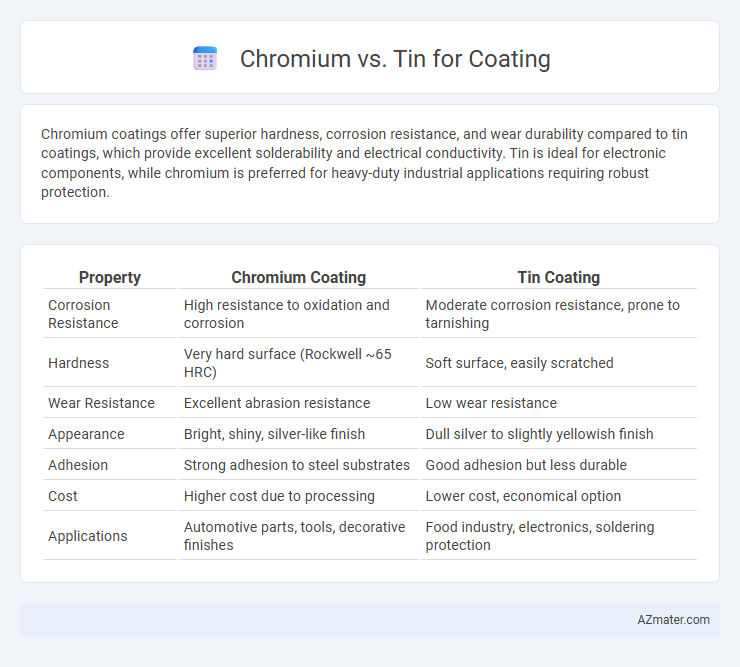Chromium coatings offer superior hardness, corrosion resistance, and wear durability compared to tin coatings, which provide excellent solderability and electrical conductivity. Tin is ideal for electronic components, while chromium is preferred for heavy-duty industrial applications requiring robust protection.
Table of Comparison
| Property | Chromium Coating | Tin Coating |
|---|---|---|
| Corrosion Resistance | High resistance to oxidation and corrosion | Moderate corrosion resistance, prone to tarnishing |
| Hardness | Very hard surface (Rockwell ~65 HRC) | Soft surface, easily scratched |
| Wear Resistance | Excellent abrasion resistance | Low wear resistance |
| Appearance | Bright, shiny, silver-like finish | Dull silver to slightly yellowish finish |
| Adhesion | Strong adhesion to steel substrates | Good adhesion but less durable |
| Cost | Higher cost due to processing | Lower cost, economical option |
| Applications | Automotive parts, tools, decorative finishes | Food industry, electronics, soldering protection |
Introduction to Chromium and Tin Coatings
Chromium coatings provide a hard, corrosion-resistant surface widely used in automotive, aerospace, and industrial applications for enhanced durability and wear resistance. Tin coatings offer excellent solderability and corrosion protection, making them ideal for electrical components and food packaging. Both metals serve distinct purposes in surface treatment, with chromium excelling in hardness and tin in corrosion inhibition and conductivity.
Chemical Properties and Composition
Chromium offers superior corrosion resistance and hardness due to its dense atomic structure and ability to form a stable oxide layer, making it ideal for protective coatings. Tin features excellent ductility and solderability, with a lower melting point and less toxicity, but provides less wear resistance compared to chromium. The chemical composition of chromium coatings typically includes chromium oxide compounds, whereas tin coatings primarily consist of pure tin or tin alloys that prevent oxidation and improve electrical conductivity.
Application Methods for Chromium and Tin Coatings
Chromium coatings are primarily applied through electroplating and physical vapor deposition (PVD), providing a hard, corrosion-resistant surface ideal for automotive parts, tools, and decorative finishes. Tin coatings commonly utilize electroplating and hot-dip methods, offering excellent solderability and corrosion protection for electronic components and food packaging. Chromium's application methods emphasize durability and wear resistance, while tin's techniques prioritize conductivity and food safety.
Corrosion Resistance Comparison
Chromium coatings exhibit superior corrosion resistance compared to tin, making them ideal for harsh environments and extended protection against oxidation and rust. Chromium forms a dense, adherent oxide layer that acts as a robust barrier to moisture and chemicals, whereas tin coatings provide moderate corrosion resistance primarily in less aggressive conditions. The enhanced durability of chromium coatings is particularly beneficial in automotive, aerospace, and industrial applications where long-term exposure to corrosive agents is prevalent.
Durability and Wear Resistance
Chromium coatings exhibit superior durability and wear resistance due to their hardness and corrosion-resistant properties, making them ideal for high-friction environments. Tin coatings, while less hard, offer excellent adhesion and moderate protection against corrosion, which is suitable for applications requiring softer, malleable surfaces. The choice between chromium and tin hinges on specific wear conditions, with chromium favored for heavy-duty wear resistance and tin preferred for moderate durability with better ductility.
Aesthetic and Finish Options
Chromium coating offers a highly reflective, mirror-like finish with exceptional corrosion resistance, making it ideal for automotive and decorative applications requiring a sleek, shiny appearance. Tin coating provides a softer, matte finish with excellent solderability and corrosion protection, commonly used in electronics and food packaging for a more subtle, utilitarian aesthetic. Both metals enable diverse finish options, but chromium delivers superior brightness and durability for premium visual appeal.
Cost and Availability
Chromium coating is generally more expensive due to higher raw material costs and more energy-intensive processing compared to tin. Tin is widely available and cost-effective, making it a preferred choice for large-scale industrial applications requiring corrosion resistance. The accessibility and lower price of tin often make it a feasible option when budget constraints are critical.
Environmental Impact and Safety
Chromium coatings, especially hexavalent chromium, pose significant environmental and health hazards due to their toxicity and carcinogenic nature, leading to stringent regulations and costly waste management practices. Tin coatings offer a safer and more eco-friendly alternative, as tin is non-toxic, biodegradable, and does not produce hazardous waste during plating or disposal. The choice of tin over chromium reduces environmental contamination and improves worker safety by eliminating exposure to harmful chromium compounds.
Typical Industries and Uses
Chromium coatings are widely used in automotive, aerospace, and industrial machinery industries due to their excellent corrosion resistance, hardness, and decorative finish. Tin coatings primarily serve the food packaging, electrical, and soldering sectors, offering superior solderability, corrosion protection, and non-toxic properties. Both metals provide distinct advantages tailored to specific industrial applications, with chromium favored for heavy-duty wear resistance and tin preferred for electronic and food-safe surfaces.
Choosing the Right Coating: Chromium vs Tin
Chromium and tin coatings offer distinct benefits based on application requirements; chromium provides exceptional hardness, corrosion resistance, and a sleek, reflective finish ideal for automotive and industrial tools. Tin excels in electrical conductivity, solderability, and corrosion protection, making it the preferred choice for electronic components and food packaging. Selecting between chromium and tin depends on factors like durability needs, environmental exposure, and compatibility with the substrate material.

Infographic: Chromium vs Tin for Coating
 azmater.com
azmater.com